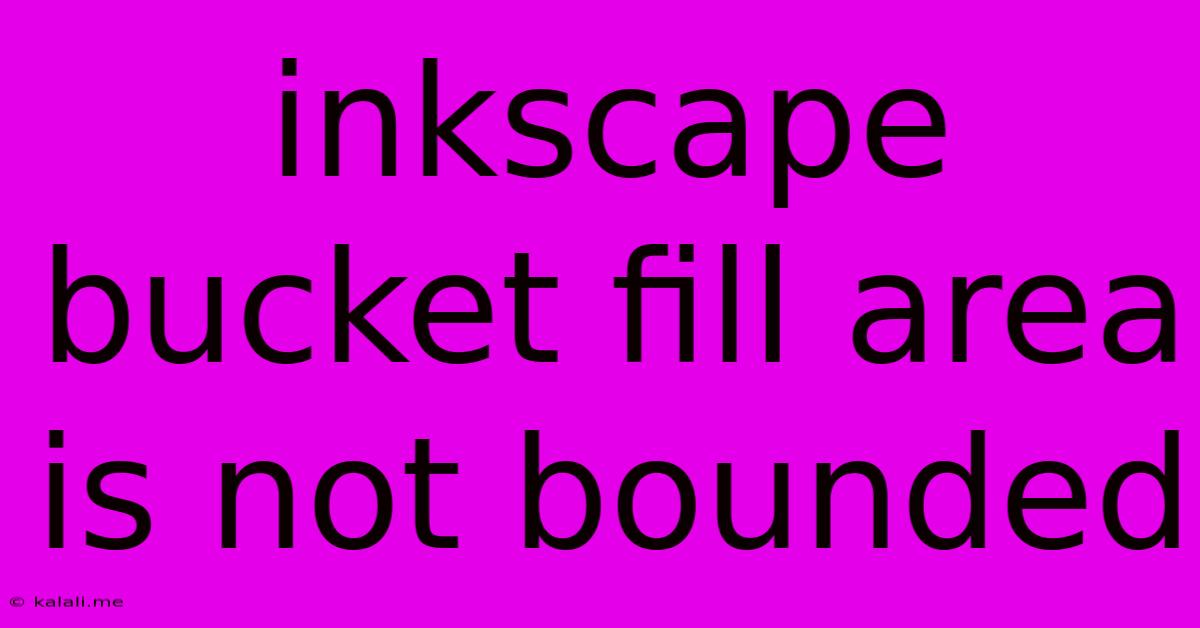Inkscape Bucket Fill Area Is Not Bounded
Kalali
Jun 03, 2025 · 3 min read

Table of Contents
Inkscape Bucket Fill: Why Your Area Isn't Bounded and How to Fix It
Inkscape, a powerful free and open-source vector graphics editor, offers a convenient bucket fill tool for quickly coloring shapes and areas. However, users sometimes encounter the frustrating issue where the fill spills beyond the intended boundaries. This article will explore the common causes of this problem and provide practical solutions to ensure your bucket fill stays neatly within the defined area. Understanding these techniques will drastically improve your workflow and prevent unwanted spills during your vector editing process.
Understanding the Inkscape Bucket Fill Tool
The bucket fill tool, often represented by a paint bucket icon, works by analyzing the area surrounding the point you click. It then fills that connected area with the selected color. The "connectedness" is determined by factors such as path continuity, node selections, and the tool's settings. When this connectedness is misinterpreted, the fill overflows.
Why Your Inkscape Bucket Fill Isn't Bounded
Several factors can cause the Inkscape bucket fill tool to spill outside the intended area:
-
Unclosed Paths: This is the most common culprit. If your shape has even a tiny gap in its path, the fill will escape through that opening. Ensure all paths are completely closed before using the bucket fill tool. Inspect your shapes closely, zooming in if necessary.
-
Overlapping Paths: If you have overlapping paths, the fill might extend into the area of the overlapping shapes, creating unexpected results. Separate and reorganize overlapping paths for cleaner fills.
-
Incorrect Node Selection: Problems can arise if nodes are not correctly connected or if there are unintended nodes present. Double-check your node arrangements and ensure they accurately reflect your desired shape.
-
Path Segmentation: A single shape might be inadvertently split into multiple paths. The bucket fill will only fill one path at a time, leading to incomplete or unbounded fills. Combine segmented paths to create a complete shape.
-
Tolerance Settings: The bucket fill tool has tolerance settings. A high tolerance might cause the fill to bleed into nearby paths, while a low tolerance could prevent it from filling the intended area completely. Experiment with adjusting the tolerance settings in the tool options.
-
Stroke Width: A very wide stroke can sometimes interfere with the fill boundaries. Consider temporarily reducing the stroke width to see if it resolves the issue.
-
Filter Effects: If you've applied filter effects to your shape, the filter's boundaries might not align precisely with the original path, leading to spillover. Temporarily remove the filter effect to test.
Solutions to Bound Your Inkscape Bucket Fill
Here's how to troubleshoot and resolve your unbounded fill issues:
-
Close Open Paths: Carefully check all paths for any gaps. Use the Node tool to manually select and connect any unconnected nodes.
-
Separate Overlapping Paths: Use the Object → Ungroup command to separate overlapping paths. Reposition them to eliminate the overlap.
-
Consolidate Segmented Paths: If your shape is divided into segments, use the Path → Union command to combine them into a single path.
-
Optimize Node Selection: Use the Node tool to examine your nodes, deleting unnecessary nodes and ensure smooth curves and sharp angles are correctly defined.
-
Adjust Tolerance: Experiment with the tolerance setting in the bucket fill tool options to find the optimal value for your specific shape.
-
Reduce Stroke Width (Temporarily): Reduce the stroke width to check if it's interfering with the fill.
-
Remove Filter Effects (Temporarily): Remove filter effects to rule out interference before reapplying.
-
Use the "Fill and Stroke" Panel: Directly setting the fill color in the "Fill and Stroke" panel (Shift+Ctrl+F) can sometimes circumvent issues with the bucket fill tool.
-
Redraw the Shape: In some stubborn cases, simply redrawing the shape can be the most efficient solution, ensuring it’s created without underlying issues.
By systematically addressing these possibilities, you should be able to effectively control the bucket fill tool in Inkscape and avoid those frustrating unbounded fills. Remember patience and attention to detail are key to mastering vector editing!
Latest Posts
Latest Posts
-
Making An Animal Jaw In Blender
Jun 05, 2025
-
Can You Plug A Surge Protector Into Another
Jun 05, 2025
-
Do You Install Cement Board Before Shower Pan
Jun 05, 2025
-
Can Wine Go Bad In The Fridge
Jun 05, 2025
-
Bash For All Files In Directory
Jun 05, 2025
Related Post
Thank you for visiting our website which covers about Inkscape Bucket Fill Area Is Not Bounded . We hope the information provided has been useful to you. Feel free to contact us if you have any questions or need further assistance. See you next time and don't miss to bookmark.